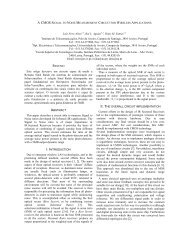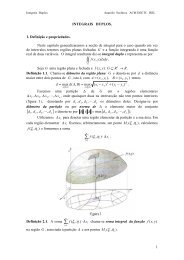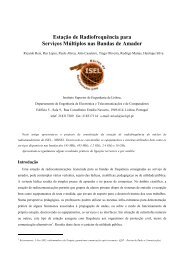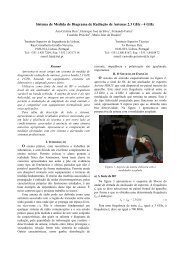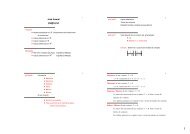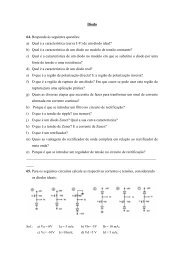NON-ADDICTIVE SAMPLE BASED FACTS - Deetc
NON-ADDICTIVE SAMPLE BASED FACTS - Deetc
NON-ADDICTIVE SAMPLE BASED FACTS - Deetc
You also want an ePaper? Increase the reach of your titles
YUMPU automatically turns print PDFs into web optimized ePapers that Google loves.
attribute keys and K is the remaining attribute. From<br />
an OLAP point of view, X1, X2, ..., Xn turn to be the<br />
axis of the cube and each value of attribute K is in<br />
the intersection of those axis. We can express K as a<br />
function<br />
K : f (X1,X2,...,Xn) (5)<br />
If one of the axis is omitted from (5), e.g Xn, we<br />
are performing a similar operation as a dimensional<br />
reduction<br />
Knew : f (X1,X2,...,Xn−1) (6)<br />
However, in (5), the result set does not contain<br />
duplicates, because the key set is contained in<br />
the projection result. In (6), to guarantee the<br />
distinction, K needs to be aggregated for each<br />
distinct tuple of the projection set PS set defined as<br />
(x1,x2,x3,...,xn)|xn ∈ dom(Xn). Using the sum as the<br />
aggregation function, the attribute K is summarised as<br />
∑<br />
xn∈dom(Xn)<br />
f (x1,x2,...,xn−1,xn) (7)<br />
The facts in the OLAP Cube does not always directly<br />
point to an a single attribute. Their definition can be<br />
based upon a mathematical operation applied to one<br />
or more data elements. These are generally referred<br />
to as derived data or derived facts [5]. If the operation<br />
defines a ratio3 , the application of (7) results in a nonmeaningful<br />
value, because ratios are non-addictive.<br />
The performance indicators cannot be pre-calculated<br />
and stored directly in the fact table; it must be implemented<br />
as a derived fact.<br />
To be able to properly calculate the performance<br />
indicators for the domain, e.g. rat, a corrective<br />
weight must be used, as can be see in (4). Since<br />
query’s targets are user depended, determined in<br />
runtime by the users’ restrictions over the Sociodemographic<br />
dimension, one can’t pre-determine the<br />
right weight to use. It’s necessary to store all the<br />
possible weights, using (3) to calculate them. For a 4<br />
attribute key cube, we are dealing with a theoretical<br />
value of 15 possible combinations, sum 4 k=1 (4 i<br />
). If one<br />
decided to stored all the possible weights as facts, for<br />
each tuple of the fact table 14 unnecessary values are<br />
stored, as only one is valid for each query. Besides,<br />
the number of possible targets increase this number.<br />
This approach is also not feasible because, for some<br />
indicators, it is necessary to store the weights for<br />
non-viewers, that is, individuals that didn’t watch<br />
television during the analysis period. Fact tables store<br />
only one type of occurrence, in this case, the fact that<br />
some individual watched television; it’s not a good<br />
3 Ratios are not the only type of non-addictive facts.<br />
practice to store the opposite fact too. One must use<br />
a more straightforward approach, using some domain<br />
knowledge.<br />
The data are quota sample-based, which means the<br />
sample was designed to be a representative subset of<br />
the population, regarding some descriptive characteristics.<br />
In this sense, it’s impossible to have an individual<br />
to support simultaneously two or more values for<br />
an attribute. For example, an individual that is present<br />
in the target males with ages ranging from 4 to 14 cannot<br />
be part of other target, females with ages ranging<br />
from 4 to 14.<br />
Property 1. Let Ta be a target with a restriction over<br />
a socio-demographic attribute a,<br />
ta=v1 ∩ta=v2 = /0<br />
If the weights are normalised, which can be done during<br />
the ETL 4 proccess, for any two or more disjoint<br />
subsets, their weights sum up to one.<br />
Property 2. Let Tb be a target with a restriction<br />
over socio-demographic two valued attribute b,<br />
∑ Ta=0∈PW(i) + ∑ Ta=1∈PW(i) = 1 is always true.<br />
Knowing that, it’s possible to create a fact table that<br />
store the weights for all possible targets, including<br />
the non-viewers individuals. That fact table shares<br />
the data and socio-demographic dimensions. Each tuple<br />
in the fact table represent the reference value for<br />
a specific combination of socio-demographic values,<br />
for a given day, applying (3) for each distinct combination.<br />
Figure 2 illustrate the Contact star-schema.<br />
Figure 2: Illustration of the contact starschema model.<br />
The former model provide the weights for all the contacted<br />
individuals, viewers or not, for one day. To calculate<br />
the performance indicators for the domain, e.g.<br />
rating, it’s also necessary to determine the weights of<br />
the viewers. To address this issue, it’s necessary to<br />
create another fact table, that store the viewers’ daily<br />
corrective weight. Since this table is indexed by all<br />
of the dimensions discussed so far, Date, Time, Program<br />
and Socio-Demographic, a tuple represents<br />
4 Extraction Transformation and Loading




